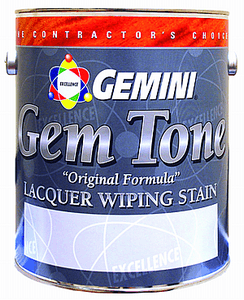Working With Wood Stain
Wood stain that doesn’t dry is not uncommon. If this happens to you it can be for a few different reasons. The first thing to consider is the type of stain you are working with.
Oil Stain. This is the most common stain and it is what most people are familiar with. This is the easiest to work with and is the most forgiving when used by non professionals. Fastest way to determine if it is an oil stain is to look at the clean-up instructions on the label. If it says to use mineral spirits, it is an oil stain. Biggest advantage to using an oil stain is it gives you plenty of time to work with it on the wood before you need to wipe it off. Oil stains usually have pigment added to them for the color but can also have dye added as well.
Water Based Stain. These replace the hydrocarbons with water as the solvent. If the label says to clean up with soap and water, it is a water based stain. These are much more difficult to work with. They dry fast and tend to raise the grain of the wood. One solution to this problem is to “precondition” the wood by raising it before staining. To do this, use a damp rag to wet the wood. Allow to dry 24 hours and then sand the grain before staining. You usually want to use a water based stain if you plan on using a water based finish.
Lacquer Stain. My favorite. Fast dry so you can get a sealer on it much sooner. More difficult to work with because of the fast drying but once you get accustomed to it, most professionals use this because projects can get done much faster. Most lacquer stains use a dye for the color. Another big plus to this stain is it can be added to lacquer finishes to “tone” the wood and make adjustments in the finished look. Lacquer stains don’t actually use lacquer as the solvent or binder. They use fast dry solvents instead. They get the name because of their use in “lacquer toning”.
Dye Stain. There are water, alcohol, and solvent varieties of dye stain. The biggest advantage to dye stains is that there is no binder so color adjustments are infinite and the grain of the wood does not become obscured. Deep penetrating and rich looking. Big disadvantage is most are sensitive to UV light and fade over time.
Gel Stain. Almost all are oil based. Easy to work with because they are so thick and stay wet long enough to be worked with. Commonly used with graining tools to give a faux wood grain to non wood items like fiberglass doors. This is really the only time we use a gel stain.
All In Ones. These are the stain and finish combos. More difficult to work with and adjust appearance. They dry very hard and fast so brush marks can be an issue. Usually a polyurethane varnish as the finish.
If you are having an issue with stain not drying it is usually going to be an oil stain or oils stain/dye stain combo. It is not uncommon to get an oil based stain that has the color adjusted with dye. The two biggest reasons for stain not drying is:
1. The environment. Too much humidity or cooler temperatures. Avoid these conditions. If you must stain in a cooler or more humid environment, like outside in the fall, switch to a stain with “high performance” tint. It will dry faster and not sit on the surface of the wood. If you already have something stained and the temperature is cool or the humidity is high let it sit for awhile. Time and air movement helps. If it is not any better after 24 hours, gently wipe it down with rags, allow surface to dry and adjust appearance with light brush coats of stain. Preferably one with high performance tint.
2. The Stain. If you are staining with a very dark stain the possibility of the stain being over tinted is high. When going with a dark color it is best to use a lacquer or dye stain. To achieve the dark color in oil based stains, so much tint and or dye is loaded into the product that drying can become a real problem. If all the conditions are right and you are using a dark stain that is not drying properly, suspect the stain. So often people assume that the products we buy are good and intended for what we bought them for. This sadly is not always the case. I did some electrical work at my home once replacing an outlet. When I was done you would get shocked if you touched the outlet. I knew I wired it correctly. I was going crazy trying to figure it out. I finally bit the bullet and called an electrician. He couldn’t figure it out either. We called another electrician. We all finally figured out that the brand new outlet was bad. None of us even considered that!
There are a few more possibilities but the above are common. Two more possible causes are not wiping enough of the stain off with your rag. This is especially true when using a “penetrating” stain with linseed oil. Penetrating stains are not designed to sit on the surface. Over sanding the wood smooth can also cause a problem when using penetrating stains because you close the grain of the wood and it becomes difficult for the stain to penetrate. Usually lightly wiping the stain with a rag and solvent, allowing adequate dry time and applying new stain will solve the problem.


